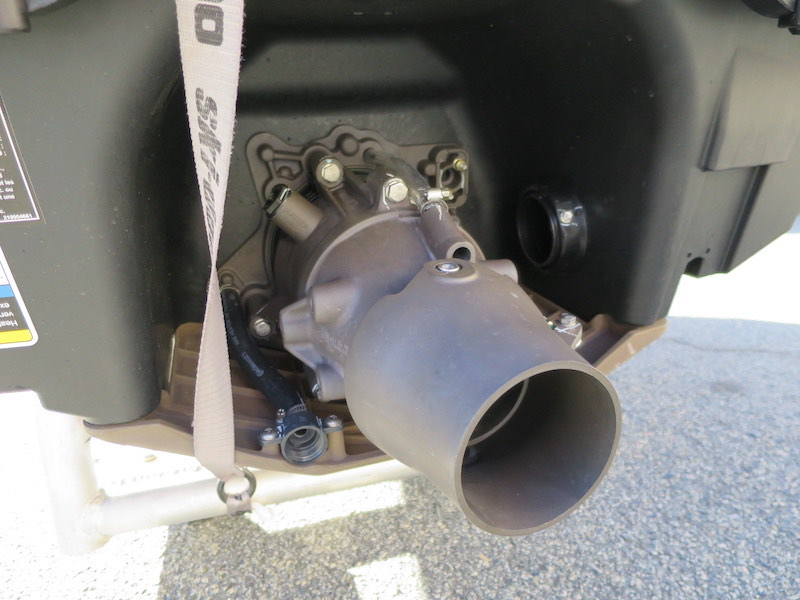Can you run a jet ski out of the water?
Yes, you can run a jet ski without it being in the water.
But you can only run it for 15 seconds at the most!
Will Running Out Of Water Damage It?
Running a jet ski out of the water is not a huge deal, it’s when you run it for over 15 seconds that it becomes a problem.
Every jet ski takes in lake or ocean water to cool the engine. Some manufacturers like Sea-Doo don’t take in water to cool the engine, but they still take some in to cool the exhaust or superchargers.
Just like a jet boat, you need water to keep the engine or exhaust from overheating.
The only good reason to start a jet ski out of the water is to make sure everything runs fine before heading to the boat ramp or to warm up the engine before changing the oil. You also have winterizing, which needs the jet ski to be out of the water to run the pink RV antifreeze through it.
Also, running your jet ski out of the water for too long can damage the carbon seal and make it sink.
15-Second Rule
I’ve seen others recommend you only run a jet ski out of the water for 15 seconds. There is no magic time, you just don’t want to run it for too long – Too long is when the alarms start to go off. Even worse is if your jet ski alarms or sensors have failed and don’t warn you.
That is why we stick to the 15 second rule. Just in case something is not working right.
Most of the time, I only run a jet ski for 10 seconds, I want to make sure it starts fine and can hear it idle for a second or two. If I need to run it for longer, I take it to the lake and back up my trailer and let it idle in the water.
When a jet ski has run out of the water for less than 30 seconds, I like to give it at least 10 minutes to cool down before starting it again.
You don’t want to run the jet ski for 30 seconds and then stop it for a few seconds and start it again, that would be very bad! You need to let your jet ski cool down for a good bit before starting it again when out of the water.
Jet Pump Needs Water
A jet ski and jet boat share a lot in common, and one thing in common is that the jet pump and bearings need to be in the water.
The jet pump has a little give in it because it’s built to work in water. This means the impeller kind of floats. If the pump is not in the water, it doesn’t have the cushion of the water, and the impeller and bearings bounce around.
You’ll notice your jet ski is much louder out of the water and sounds like someone jiggling a bunch of keys in a metal box. That is the pump, and it’s bearings bouncing, and if they’re run too long out of the water, they’re getting trashed and overheated.
How To
To run a jet ski out of the water is super simple. Most jet skis like Sea-Doo’s have a flush adaptor that is threaded to fit a garden hose.
Other manufacturers like Yamaha or Kawasaki will need a flush adaptor kit to fit your garden hose.
Note: Running a jet ski on a garden hose is not a replacement for running it in the water. The pump is not floating and not being adequately cooled. This is how you wear out carbon seals which can sink your jet ski, so it’s better to take it to the water instead of using the hose.
Also, the water intakes for a jet ski is different than the one from the intake of the flush adaptor. I’ve seen a jet ski run fine on a hose but not so well when in the water, keep this in mind when buying a used jet ski as some sellers can trick you this way.
Important Procedure!
The way you flush a jet ski is VERY DIFFERENT than a regular boat!
You must follow the correct order:
- Turn the jet ski engine on.
- Turn water on.
- Run for 30 seconds.
- Turn water OFF.
- Rev the jet ski engine a couple of times lightly.
- Let jet ski run idle for 5 seconds.
- Turn jet ski off.
You must have the jet ski engine on first, then turn the water on. When it’s time to stop you turn the water off first and then the engine.
If in doubt consult your owners manual.
I’ve added the rev and wait a little bit to help get any extra water out of the exhaust. This is what I do, and it seems to work fine for me.
How To Flush A Sea-Doo
Here is a great video showing you how to flush a Sea-Doo watercraft.
How To Flush A Yamaha
Here is how you flush a Yamaha jet ski.
How to Flush A Kawasaki
Here is how you flush a Kawasaki jet ski.
Note: Some models like this Kawasaki above have 2 flush ports. One is for the engine and the other is for the intercooler. This video does a really good job of showing how to flush each port properly. He even agrees with my 15 to 30-second rule of not running on the water too.
